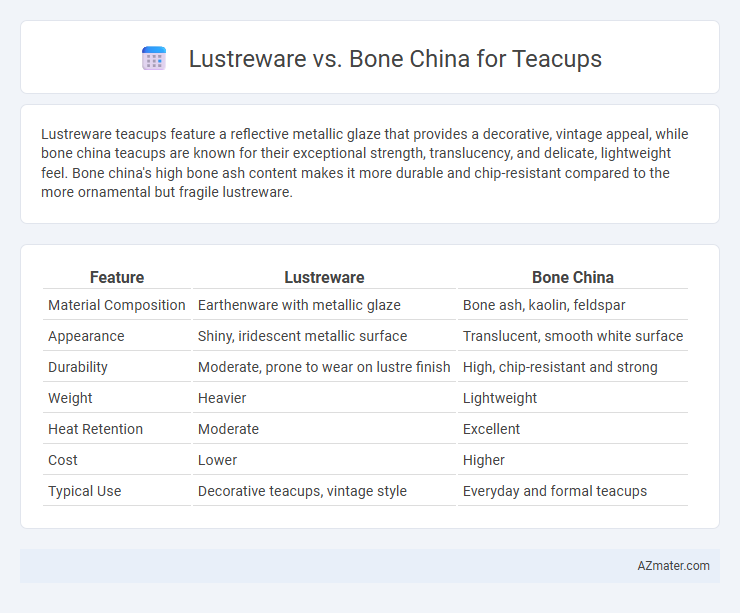Lustreware teacups feature a reflective metallic glaze that provides a decorative, vintage appeal, while bone china teacups are known for their exceptional strength, translucency, and delicate, lightweight feel. Bone china's high bone ash content makes it more durable and chip-resistant compared to the more ornamental but fragile lustreware.
Table of Comparison
| Feature | Lustreware | Bone China |
|---|---|---|
| Material Composition | Earthenware with metallic glaze | Bone ash, kaolin, feldspar |
| Appearance | Shiny, iridescent metallic surface | Translucent, smooth white surface |
| Durability | Moderate, prone to wear on lustre finish | High, chip-resistant and strong |
| Weight | Heavier | Lightweight |
| Heat Retention | Moderate | Excellent |
| Cost | Lower | Higher |
| Typical Use | Decorative teacups, vintage style | Everyday and formal teacups |
Introduction to Lustreware and Bone China
Lustreware is a type of pottery characterized by its iridescent metallic glaze, often found in decorative teacups with a shimmering finish that reflects light beautifully. Bone china, renowned for its high durability and delicate translucency, incorporates bone ash in its composition, resulting in a lightweight yet strong teacup material favored for fine dining. Both Lustreware and Bone china offer unique aesthetic and functional qualities, with Lustreware prized for its vibrant metallic look and Bone china valued for its refined elegance and resilience.
Key Material Differences
Lustreware teacups feature a metallic glaze finish created by firing powdered metals onto the ceramic surface, resulting in a reflective, iridescent appearance, whereas bone china teacups are composed primarily of bone ash, kaolin, and feldspar, offering superior strength and translucency. The key material difference lies in bone china's high percentage of bone ash (typically 30%-50%) which provides its characteristic whiteness and chip resistance, while lustreware relies on surface treatment rather than material composition for its decorative effect. This fundamental contrast influences durability, aesthetics, and maintenance requirements between the two teacup types.
Historical Background and Origins
Lustreware, originating in the early 19th century, is known for its iridescent metallic glaze developed through a unique firing process that reflects a rich heritage from Middle Eastern and European pottery traditions. Bone china, introduced in England during the late 18th century by Josiah Spode, incorporates bone ash for enhanced strength and translucency, revolutionizing fine porcelain craftsmanship. Both materials represent significant advancements in ceramic art, with Lustreware emphasizing decorative sheen and Bone china focusing on durability and refined elegance.
Manufacturing Processes Compared
Lustreware teacups undergo a unique manufacturing process involving the application of metallic glazes that create an iridescent sheen, requiring an additional firing step at lower temperatures to preserve the lustrous finish. Bone china production incorporates bone ash, kaolin, and feldspar, resulting in a dense but lightweight porcelain fired at higher temperatures for enhanced strength and translucency. Lustreware's decorative glazing contrasts with bone china's emphasis on material composition and firing methods to achieve durability and delicate appearance.
Aesthetic Appeal and Visual Qualities
Lustreware teacups exhibit a shimmering, iridescent glaze that catches light and adds a vintage charm, making them visually striking and unique collectibles. Bone china teacups, known for their translucent, delicate, and smooth finish, offer a refined elegance with subtle radiance and finely detailed patterns. The choice between lustreware and bone china hinges on whether one prefers a bold, reflective surface or a classic, pristine look that complements traditional tea settings.
Durability and Practicality for Teacups
Lustreware teacups are known for their decorative metallic glaze, which can be prone to wear and scratching, affecting long-term durability. Bone china offers superior strength and chip resistance due to its high bone ash content, making it more practical for daily use and frequent handling. The non-porous surface of bone china also ensures better resistance to staining and easier maintenance compared to the more delicate lustreware finish.
Collectibility and Market Value
Lustreware teacups are prized for their iridescent glaze and vibrant colors, making them highly collectible among vintage enthusiasts, especially pieces from the early 20th century. Bone china teacups, known for their translucency, durability, and fine craftsmanship, command higher market values due to their association with prestigious manufacturers like Royal Crown Derby and Wedgwood. Collectors often value bone china for both its aesthetic elegance and long-term investment potential, whereas lustreware appeals to those seeking distinctive decorative appeal and affordability.
Maintenance and Care Considerations
Lustreware teacups require gentle handling and handwashing with mild detergents to preserve their metallic sheen, avoiding abrasive materials that can damage the delicate finish. Bone china teacups offer greater durability and are generally dishwasher safe, but should still be handled carefully to prevent chipping. Both materials benefit from storing away from direct sunlight and extreme temperatures to maintain their aesthetic and structural integrity over time.
Sustainability and Environmental Impact
Lustreware teacups, made with metallic glazes over ceramic, often involve mining and processing of metals like gold or platinum, which contribute to higher environmental footprints due to resource extraction and energy-intensive production. Bone china, composed of bone ash, kaolin, and feldspar, relies on animal bone waste but offers greater durability and longevity, reducing the frequency of replacement and overall material consumption. Sustainability considerations favor bone china for its longer lifespan and lower toxic emissions during manufacture, while lustreware poses challenges related to metal sourcing and glaze disposal.
Which Teacup is Right for You?
Lustreware teacups offer vibrant, metallic finishes with a vintage charm and durability ideal for collectors seeking decorative appeal. Bone china teacups provide a lighter, more delicate feel with superior chip resistance and translucency, perfect for elegant daily use or formal occasions. Choose lustreware for bold aesthetics and collectibility, while bone china suits those prioritizing refined elegance and practical durability.

Infographic: Lustreware vs Bone china for Teacup
 azmater.com
azmater.com